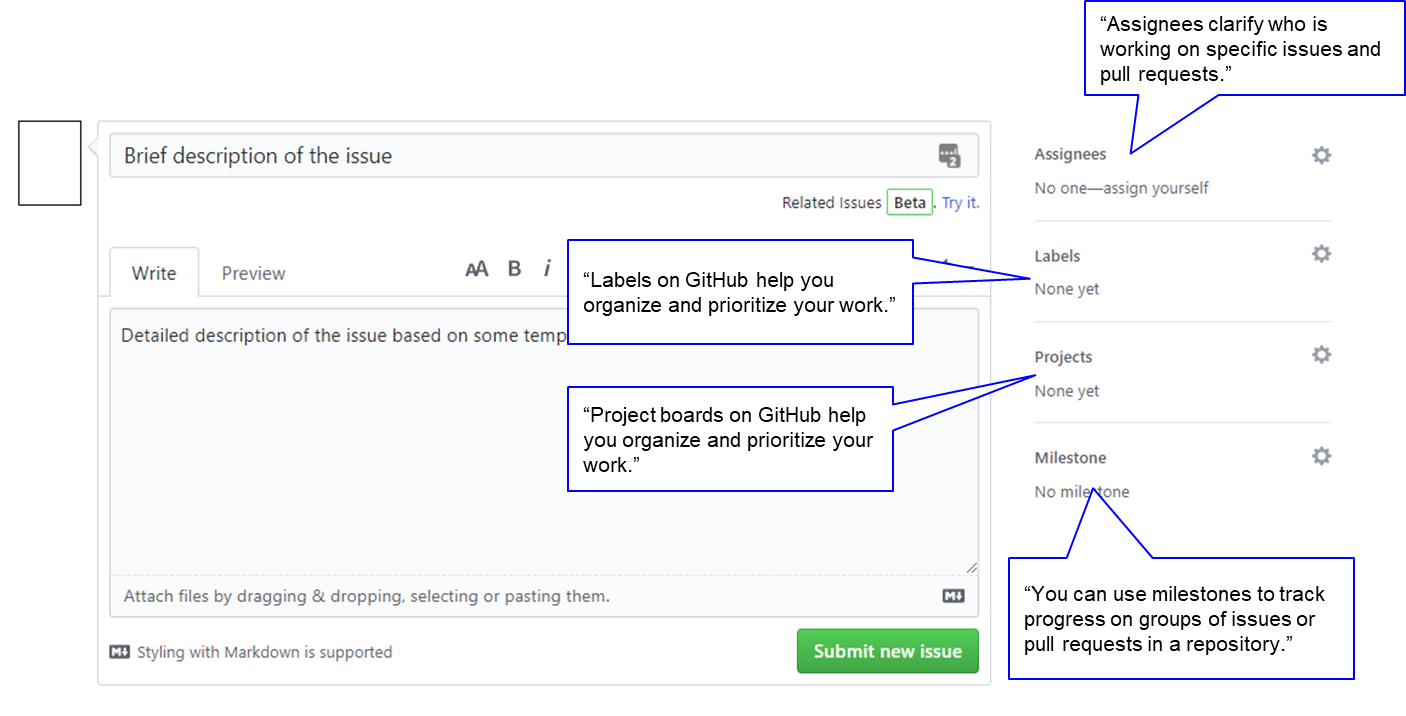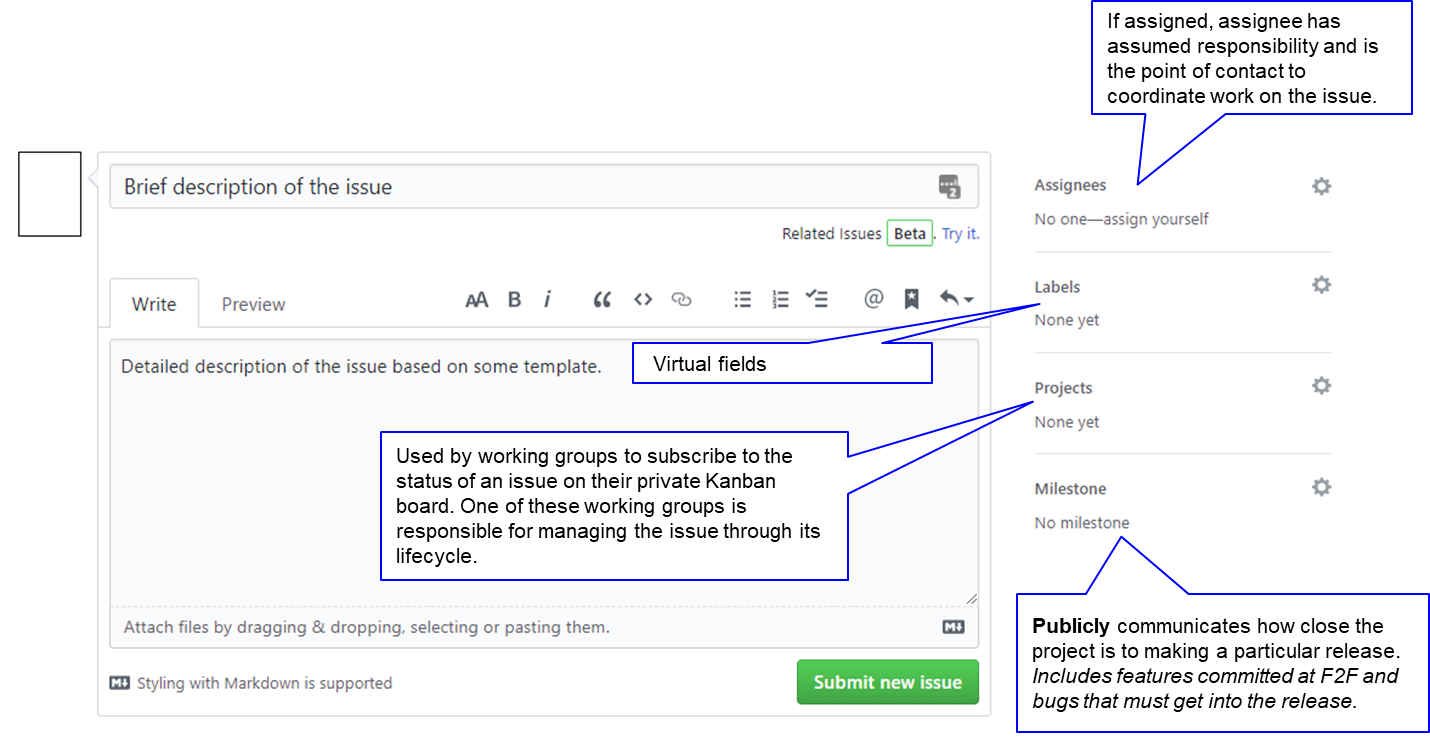Background
As activity in the EdgeX Foundry project has increased, it has been increasingly difficult for interested stakeholders to comprehend the progress that has been made towards a particular release and the work that it still outstanding. The Linux Foundation does not supply a standard set of project management tools that could be used for this work and a free-to-use for open-source commercial tool has not been identified. Consequently, the project has decided to settle on—for now—the free tools that come with GitHub. Unfortunately, the tools that come with GitHub provide only mechanism and no policy:
Figure 1: GitHub New Issue form and GitHub-supplied documentation
This document proposes a project and issue management standard for use within EdgeX community. It is written from a data quality perspective: actionable data is high-quality data. High-quality data demands documentation of the business process around the data and providing clear definitions as to what the data means and how it is used. High-quality data requires that participants opt-in to these definitions and take an active role in ensuring that the data in the system is managed in compliance with the standard. It will then be possible to build reports on top of the underlying data to provide an accurate representation of the state of the project at any given time.
Issue Management Standard (GitHub)
In order to achieve the high data quality needed for reporting and project management purposes, the project must attach meaning to the various fields and the participants must be disciplined in their issue management processes. For example, here is the new issue form (Figure 1) with more meaningful descriptions:
Figure 2: GitHub New Issue form with more meaningful data definitions
GitHub Issue and Pull Request Field Definitions
Definition: Issue is an umbrella term that represents lifecycle-managed textual discussion about the GitHub-hosted software and documentation. An issue can be used to discuss planned work, software defects, questions about the product, or other textual discussion. Issues have fields and metadata associated with them that can be used for filtering or searching, and have lifecycle information where the lifecycle of an issue terminates in a "closed" state. Issues are not code.
Definition: Pull Request contains all the fields of an Issue, but additionally a reference to code that is being proposed for delivery to the Git repository.
Issue Core Fields Definitions
The fields in GitHub issues and pull requests mean the following in the EdgeX Foundry repositories:
Field | Definition |
author | An audit field that is automatically set to the creator of the issue or PR. |
title | A brief summary of the contents of the issue or pull request
Business rules: · Required always |
description | The first comment box after the title is the description. It provides the long description regarding what the issue or pull request is about. For pull requests, the description contains the body of the commit message and additional metadata used by GitHub for automation purposes, such as "Fixes #" tags.
Business rules: · Required always |
comments | Every comment box after description forms a running log of the community discussion of the issue or pull request. Diagnostic information from automation or bots may appear in comments as well. |
assignees | If assigned, the assignee has assumed responsibility and is the point of contact for coordinating work on the issue. The assignee must be a project member. For pull requests, this field has no special meaning: if set, it is usually set to the author. Business rules: · Required for all in-progress issues · Recommended for all release backlog issues |
reviewers | (Pull requests only.) List of project members who are solicited to review the pull request. |
labels | Labels are used to implement virtual fields. See "Virtual Field Definitions" below. |
projects | Projects are used by EdgeX working groups to subscribe to the status of an issue on their project board. One of these working groups is responsible for managing the Issue through its lifecycle. An Issue may be on multiple boards simultaneously. |
milestone | All milestones in EdgeX refer to releases. The milestone field is used to include the issue in this release's backlog. It indicates a commitment to resolve the issue by the named milestone. (For retroactive milestones, it would be used to flag the issue as "wontfix".) Milestone is a single-select field: only one milestone can be selected at a time. |
Table 1: Issue and Pull Request Field Definitions
Virtual Field Definitions
The "labels" field is used to implement virtual fields. All virtual fields are optional unless otherwise specified. These are defined as follows:
Virtual Field | Definition |
issue_type | Indicates the type of issue (single-select):
Business rules:
|
close_reason | Explains why an issue was closed (without a fix) (single-select):
Business rules:
|
subsystem_affected | Indicates the scope of the proposed change (multiple-select):
|
release_affected | A multiple-select field used for bugs only that indicates a release of EdgeX which is affected by the issue. Note, there may be multiple release_affected labels if the issue exists in more than one EdgeX release. For feature development work, the milestone field is the official field used for release planning. (This changes the current practice so there will be a transition period where both fields are used.) If multiple release_affected tags exist and the issue is only fixed in one of these releases resulting in the issue being closed, if any of affected releases is either an active development release or an LTS release, then a new issue should be opened with release_affected set accordingly. This allows the issue to continue to be tracked in the other affected releases where it makes sense to do so. Values:
Business rules:
Exceptions:
|
exception | Indicates an exceptional condition outside of the normal workflow (multiple-select):
|
priority | Priority is used to influence where to put resources and what features to cut when a release window is closing (single-select). The permissible values for priority and suggested guidance around their usage are:
|
Table 2: Virtual field definitions
Status / State Machine
There is no "status" field in GitHub. Issues are either "open" or "closed". However, issues may be assigned to project Kanban boards and can be moved from column to column in order to provide advanced status reporting. The current column of an issue is represented below as "status." Issues may freely move from state to state without restriction. Moreover, each working group may have its own customized state machine. The table presented below is the project-recommended values. Unless otherwise specified, issues must be manually moved from state to state.
Status | Meaning |
new issue | Default state for incoming issues when assigned a project. New issues require triage into either "icebox" or "release backlog" status. |
icebox | There are no current plans to work on the issue in the near-term. |
release backlog | The issue is planned for the upcoming release or be retroactively fixed for a previous release. |
in progress | Someone has started working on the issue |
QA/Code Review | A state reserved for pull requests that have not been approved. GitHub automation automatically places new pull requests here. |
Done | Terminal state for all issues and pull requests. GitHub automation will move issues and pull requests here automatically when they are closed. |
Table 3: Project-recommended issue status values
Figure 3 below shows the idealized state machine for issues. This is the recommended flow but working groups may customize this flow to one more suitable for their unique requirements.
Figure 3: Idealized state machine
Bugs affecting more than one release
When a bug affects more than one release, multiple issues shall be filed, one against each affected release. (Typically, this will be against the current supported release and release-in-progress.)
The following issue fields should be set:
- title = (as desired) + "in <release-name>"
- issue_type = bug
- priority = (as desired)
- release_affected = <current release>, <next release>
- milestone = <release-name>
- project = (depends)
If the bug is not going to be fixed in a particular release, the close_reason should be set to wontfix and an appropriate comment made as to the reason the bug was so dispositioned. Bugs that will be fixed should go through the normal bug handing process.
Release stabilization procedures
Release stabilization is the period of time between code freeze (when a git branch named after the release is made) and when the official EdgeX release is declared (container images and snaps published). During release stabilization the following procedures apply:
- Every PR must have an associated bug (against the code-freeze branch).
- A second bug must be filed against the next release for fixing the issue in the master
The procedures for "Bugs affecting more than one release" should be used for the associated bugs.
Project management
The project management system draws on the high-quality data of the issue management system. The project management system is designed to provide high-level decision support for release activities, and to provide visibility to interested stakeholders on the state of the project.
There are two primary mechanisms used for this:
- GitHub milestones — mostly for public consumption
- Project (Kanban) boards — the primary mechanism used by EdgeX project members
GitHub Milestones
GitHub milestones provide a public view of release progress and can give a coarse approximation as to how close the project is to the next release milestone.
For example, this what the GitHub milestone for Fuji release looked like in the week following the Geneva planning face-to-face.
Contrast this to the GitHub milestone for Geneva at approximately the same time:
One problem with GitHub milestones are that they are tracked on a per-repository basis. Since an EdgeX release is made of code form multiple repositories, looking at a single repository's milestone, such as edgex-go, is insufficient to get the health of the entire project.
Something more is needed.
Project (Kanban) Boards
GitHub provides a facility called a "project" that allows for organizing work. These projects can be created at a per-repository level or at the organization level. The project boards function as a Kanban, which customizable swim lanes and some basic automation for state transitions between swim lanes. In the Issue Management section we talked about how these project board are used to implement a more granular issue state machine than "open" and "closed." In this section, we describe how these boards are used for project management.
Using Project Boards to inform release decisions
The following project boards have been created at the organization level:
- Systems Management WG
- Security WG
- QA/Test WG
- Device WG
- Core WG
- Certification WG
- Applications WG
- Devops WG
These project boards map 1:1 with the standing EdgeX working groups where contributions to the code base are coordinated.
The overall project state can be ascertained by navigating to each of the above project boards and counting the issues in each column.
Figure 4: Project board standard swimlanes
The project is ready for code-freeze when the "release backlog" is empty, and there are very few issues remaining in the "in progress" and "QA/Code review". The project boards should remain in this state until the release is cut.
Project board states at other important project milestones
End of a release cycle
At the time of code freeze, the project boards should resemble the following state. Notably, the backlog should be empty, and the project should only be working on bug fixes for the impending release. The project may stay in this state for several as the entire framework is regressed and bug fixes made.
After code-freeze, it is technically possible to begin making changes for the next release. This early work should be done by directly picking items out of the "icebox" and putting them into "in progress." It is expected that as the project matures in its release practices, the duration the uncomfortable state between code freeze and release will shorten from several weeks to several days. There is no good way with the current tools to filter the project boards based on release.
A new release cycle is started by an announcement that the official release has been made.
Beginning of a release cycle
At the beginning of a release cycle, working groups pull selected backlog from the icebox into the release backlog. This backlog is presumed to have been groomed prior to the planning face-to-face and ratified there, then, when the release branch for the previous release is made, the done items from the previous release are archived, and the backlog for the next release is pulled into the release backlog column:
From this point forward, issues gradually transition to the "done" state:
Attachments









